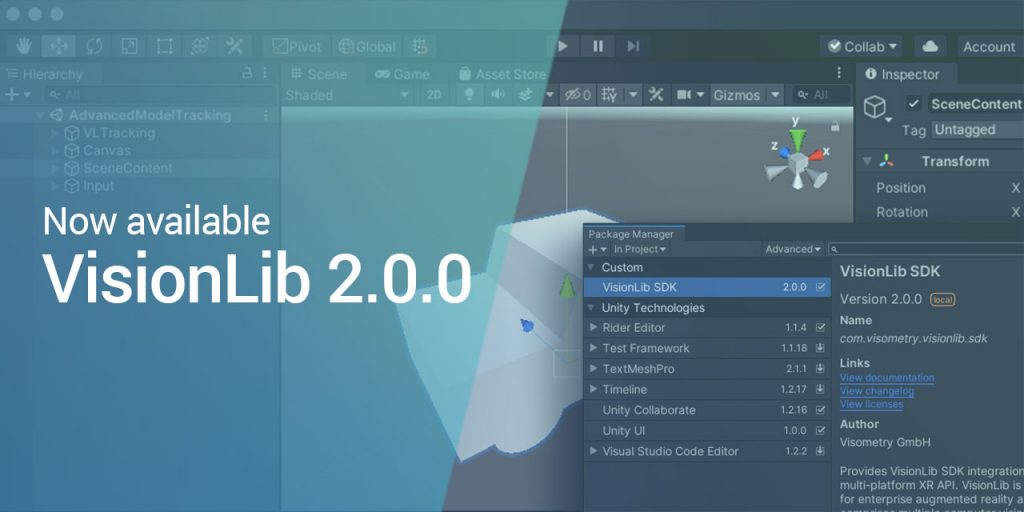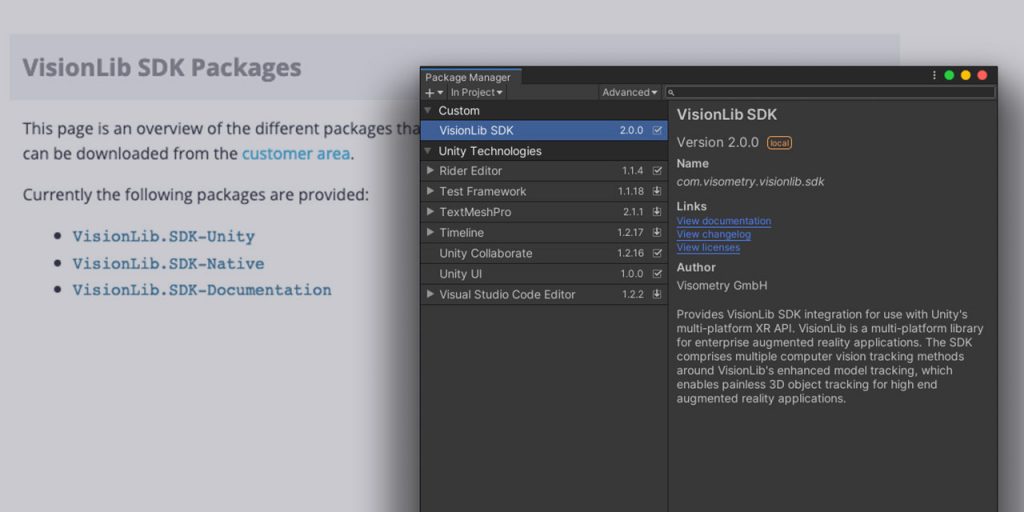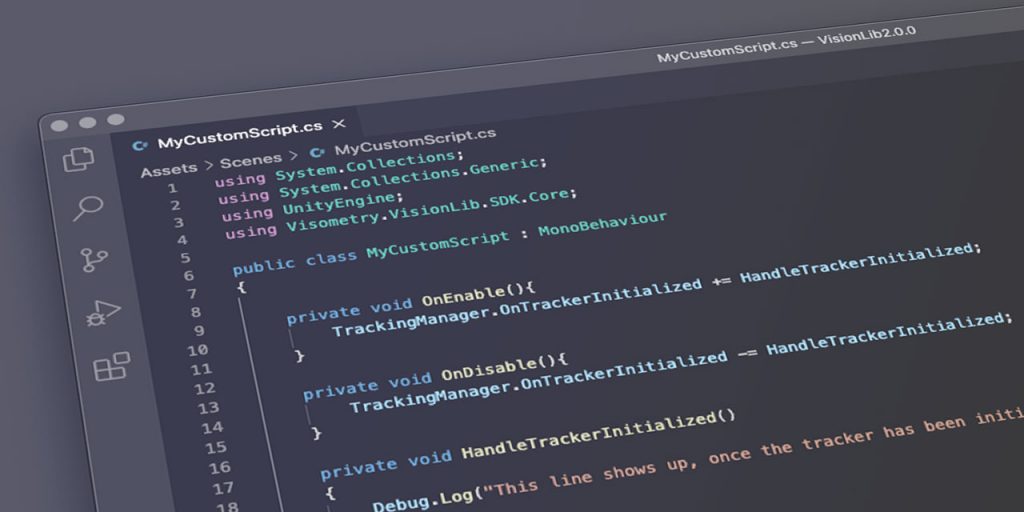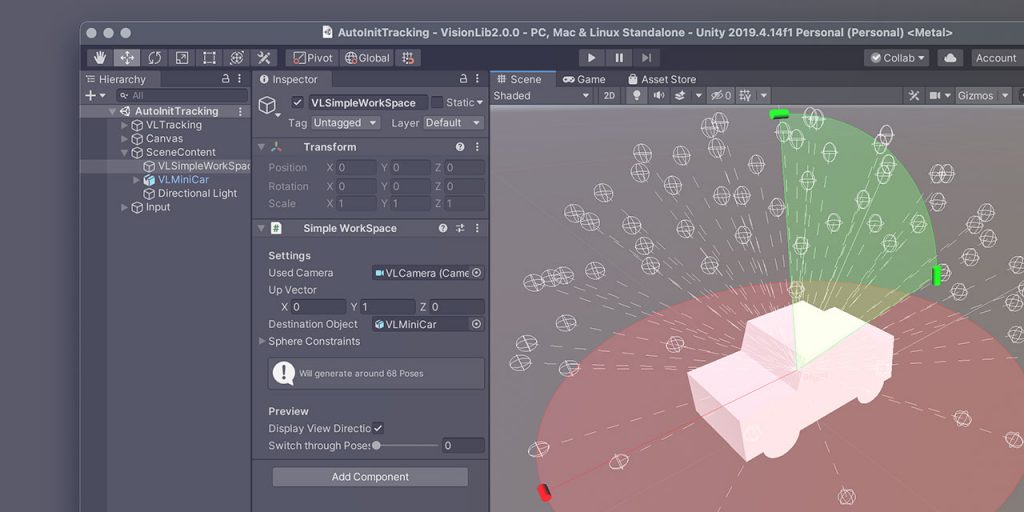
VisionLib’s Developer Update is now available here at visionlib.com.
This is truly a major update to VisionLib’s core, targeting easier development. It comes with many interface improvements, cleanup of core functions and APIs, and enables to install VisionLib with UPM, Unity’s built-in Package Manager.
With this step, VisionLib gets a fresh versioning: with UPM distribution we begin a new era of semantic versioning, which turns the release’s new name into VisionLib 2.0.0.
The major developer update includes:

VisionLib’s Unity SDK is now distributed as an UPM package, which means you can manage it using Unity’s built-in Package Manager. This did not only affect the package’s versioning, which now complies to semantic versioning guidelines. The package itself got a cleanup and is now easier to maintain, and it comes with an easier upgrade process, when integrating future VisionLib versions into your projects.
Semantic Versioning expresses versions as MAJOR.MINOR.PATCH, where MAJOR introduces one or more breaking changes, MINOR introduces one or more backward-compatible API changes, and PATCH only introduces bug fixes with no API changes at all.
Please note that UPM affects the way you now add and integrate VisionLib into your Unity projects. You also need Unity 2019.x or higher. Officially we recommend using 2019.4 LTS.
Learn in our dedicated step-by-step instruction and migration guide how to add VisionLib to a project using UPM.
The examples as well as extensions for HoloLens and ARFoundation have been separated from the core SDK. It is now easier for ›starters‹ and ›pros‹ to separate essential core modules from examples, and from extensions you might not need every time.
Downloading VisionLib, you now get a couple of packages: a tarball package for UPM, a .unitypackage with the examples and the extensions cleanly separated from those two. After installation, VisionLib’s core SDK folder has moved to Packages/, whereas examples remain placed in Assets/. The documentation can now be downloaded separately, if needed for offline use.
We’ve prepared a comprehensive overview on the new structure.

The new release introduces major changes and a clean up to its API, including naming changes, the introduction of namespaces and assembly definitions. The changes highly improve the readability and comprehensibility of VisionLib components.
Most relevantly, the VL prefix and the Behaviour or Wrapper postfix of several scripts have been removed, as have several scripts been renamed further to better fit their purpose. A huge change, but with good impact on easier development.
With this release we also introduce a Task based interface to control VisionLib via commands. This makes development with the asynchronous parts of the VisionLib interface easier to use and to understand. It brings more control during development and exception safety at runtime. For details, see Using Commands and Tasks.
Check out both, our full release notes and our comprehensive migration guide with a detailed list to all changes, which helps to quickly upgrade existing VisionLib projects.

Updates to AutoInit
With this release we introduce a couple of updates and simplifications to AutoInit, to make its setup process less error-prone.
We’ve added the SimpleWorkSpace as a simple mode to define AutoInit WorkSpaces. And we’ve added context menu entries to create both, Advanced- and SimpleWorkSpaces, which liberate the setup from the boiler plates of the example scenes. There is also a new parameter maxImageSize to make the behavior of AutoInit independent of the size of the tracking image.
Logs & Notifications Improvements
VLNotifications prefab enables to display tracking related messages in the UI if desired, as they are not displayed by default anymore.GeneralSettings component lets developers control the global log level and therefore the frequency and type of notifications shown in UI and console. Initialization issues and VisionLib events are now shown automatically depending on that log level.Get HostID & SDK Version Easier
With this version we introduce a new VisionLib > About dialogue, which makes it easier to get HostID and current SDK version – both essential information for licensing. The new dialogue is directly accessible from the Unity Editor’s main menu bar and gathers this essential information at one place.
Other Feature Updates
TrackerEventsProvider component, that lets you react to events like OnTrackerInitialized and OnTrackerStopped easily through the inspector, without the need to write code.VLPosterTracker prefab that can be used to call poster tracker related commands.The new release comes with many more updates and bug fixes. Get a full overview on all changes below:
We help you apply Augmented- and Mixed Reality in your project, on your platform, or within enterprise solutions. Our online documentation and Video Tutorials grow continuously and deliver compresensive insights into VisionLib development.
Check out these articles: Whether you’re a pro or a starter, our new documentation articles on understanding tracking and debugging options will help you get a clearer view on VisionLib and Model Tracking.
For troubleshooting, lookup the FAQ or write us a message at request@visionlib.com.